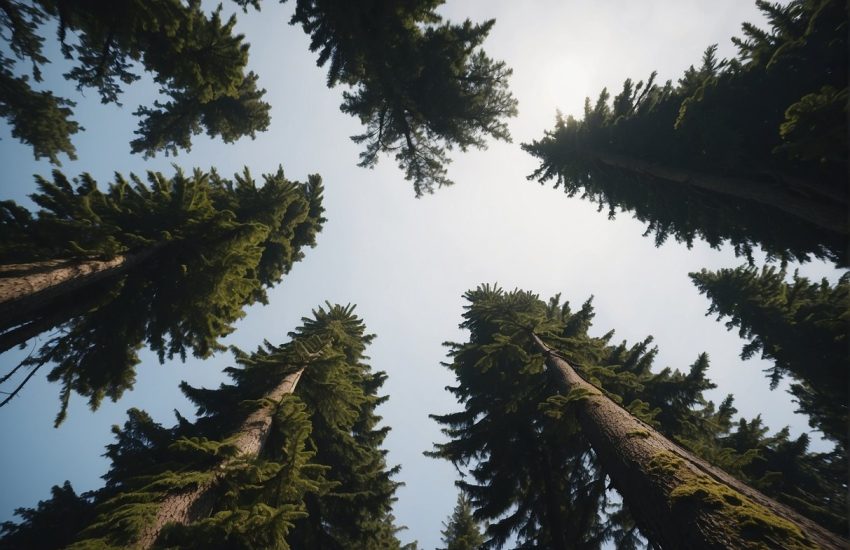The Best Cedar Tree Varieties to Plant in Idaho
Cedar is a perfect choice if you’re looking for a tree that’ll produce beautiful, long-lasting logs in your backyard. There are wide varieties of cedars available, each doing best based on the conditions in which they are grown. Cedar trees can grow up to 80 feet tall, depending on the geographical conditions. These trees also make for beautiful landscaping plants. Here are the best cedar trees to grow in Idaho.
Siberian Cedar (Pinus sibirica)
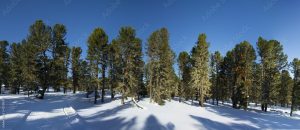
The Siberian cedar is a deciduous tree native to the Siberia region and Asia. They grow well in U.S. Department of Agriculture zones 1 through 6. The Siberian Cedar tree grows up to 50 feet tall and can easily reach widths up to 15 feet. It prefers to live in full sunlight, and it will grow in a variety of soil types as long as they are well-draining. This is one of the few cedar trees that can thrive in dry, rocky soil. It’s very resistant to pests and can easily withstand temperatures as low as -58 degrees Fahrenheit. The trees are fast-growing, but through pruning, you can easily maintain at least 12 feet between the trunk and the first branch on each side, preventing them from overgrowing. The tree is very hardy and makes for a good choice in cool climates. What’s more, the nuts contained in its pinecones are edible. In landscaping, Siberian Cedar is best suited for large landscapes.
The green needles grow in clusters between 4 inches and 6 inches long. They are soft and flexible, and they smell like evergreens. The bark is somewhat thin, but it’s also very smooth.
Because these cedar trees grow to be so tall and wide, they are prone to splitting in the middle of the trunk when they get too heavy. Due to their immense size, they will also have problems with their branches falling off in strong winds or in heavy snowfall. You can fix this by trimming the trees or harvesting them on time if they are near your homestead.
White Cedar (Thuja occidentalis)
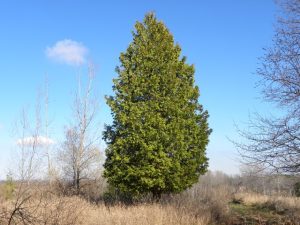
The White Cedar is native to the eastern parts of Canada, the northeastern parts of the U.S., as well as Alaska. It can also be found growing in Europe and Asia. The White Cedar thrives in USDA zones 2 through 8, which means that it’s a little more cold-hardy than most other trees on our list. This tree can grow up to 60 feet tall and reach up to 20 feet wide. It’s also extremely resistant to wind damage, which makes it a good tree for coastal regions. The White Cedar is very receptive to nitrogen and can even grow in poor soil without any extra care. Much like the Siberian Cedar, the White Cedar has soft needles that grow in clusters. Their color ranges from green to yellow-green, and they have a distinctive scent similar to that of cedars. The tree also has unique bark. It’s wrinkled by nature and can be very thin in some places. The White Cedar is known for developing an interesting layered effect with its trunk as it ages.
The White Cedar doesn’t need to be trimmed regularly, though you can remove dead branches in order to maintain the tree’s attractive shape. If you leave the tree be and let it grow naturally, it will produce long, straight trunks of up to 30 feet. White Cedar is a prevalent ornamental choice for most gardeners. This is because it can be shaped into small globe shapes or tall and slime types, depending on your preference. The tree can start producing cones as soon as it reaches one year of age. The cones are green, and they grow between 2 inches and 4 inches long. They are also very aromatic, making for a pleasant natural smell that will fill up your entire yard.
Japanese Cedar (Cryptomeria japonica)
The Japanese Cedar tree is what you’d call an evergreen conifer. This means that it will stay fresh and green throughout the whole year. It’s native to southwestern Japan and the eastern parts of China. It can also be found in other parts of Asia, though it’s usually used as an ornamental tree.
It thrives in USDA zones 5 through 7, which means it can stand a little less cold than most trees. The Japanese cedar is also very drought-tolerant and doesn’t need much supplemental water to survive. It prefers to grow in areas with full sunlight but can also survive in a shady environment. It will grow up to 60 feet tall and spread out along its branches about 15 feet. The cedar is resistant to pests and other damage, though it can easily suffer from a case of insect infestation. It has flat-looking needles that grow in clusters. They are dark green with some yellow stripes on their ends. The cones will be red at first, eventually turning into black specs when they dry out. Japanese Cedar trees have rough bark that can be as much as 2 inches thick.
Japanese cedar can be grown in climates characterized by high humidity and rainfall. The tree will produce a large number of cones each year, usually around the region’s fall season. These nuts are edible and can be used for medicinal purposes.
Port Orford Cedar (Chamaecyparis lawsoniana)
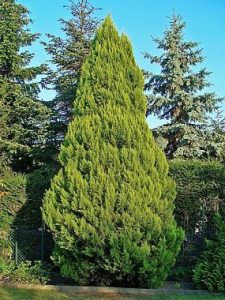
The Port Orford Cedar is native to the pacific and northwestern parts of North America, including the northwestern parts of California, Oregon, Washington, and British Columbia. It can also be found in a few parts of Canada. It thrives in USDA zones 5 through 8; It’s one of the few conifers that are naturally resistant to cold, which means that it can survive in areas with high snowfall and extremely low temperatures.
It grows up to 200 feet tall, and its branches spread out 12 feet, making it one of the biggest and most wide-spreading trees on our list. It also likes to consume a lot of light, and its branches have obvious outward signs of age, making for an attractive overall appearance.
The Port Orford Cedar can be identified by its flat needles that grow in a clump. They are dark green with some yellow stripes on their ends and up to 2 inches long. The cones are amber when they first grow, but once they dry out, the tips turn black. You can grow the Port Orford Cedar in a variety of sites, as long as it’s given enough soil moisture. You will have to keep an eye out for wood-boring insects and other pests, especially if you want to use the tree for lumber.
The Port Orford Cedar is also a popular ornamental choice for most gardeners. This is because of its unique shape and its ability to create shade. Additionally, the plant can be dwarfed by average and small size landscapes.
Alaskan Yellow Cedar (Xanthocyparis nootkatensis)
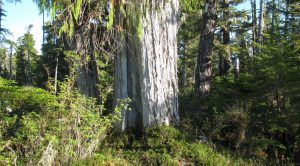
The Alaskan Yellow Cedar tree is native to Alaska and the northwestern parts of Canada. It grows up to 80 feet tall, though it doesn’t thrive in conditions of extremely low temperatures.
It’s most common in USDA zones 4 through 7. The Alaskan Yellow Cedar’s needles are flat, and they are very dark green with some white stripes on their ends, and they grow in a clump. They’re around 1/2 inch long. The cones are green at first, but once they dry out, the tips turn black. They grow about 3 inches long.
The Alaskan Yellow Cedar is best known for its amazing scent and its ability to ward off pests from other species. The branches of the tree grow very fast when you allow them to mature naturally, as opposed to when you try to prune them. The tree’s bark is also very rough and has some furrows. From a distance, its woody texture will look very similar to that of the Cascara or the Arborvitae tree. You can grow it in either full or partial sunlight.
The Alaskan Yellow Cedar is popular among gardeners because of its scent and height (it grows fast when left alone ). It’s also resistant to pests and diseases and easy to maintain.
Eastern Red Cedar (Juniperus virginiana)
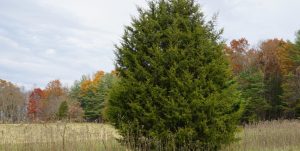
The Eastern Red Cedar is native to the mid-Atlantic and northeastern regions of the United States. It grows up to 90 feet tall and has a growth rate that tops out at 1 to 2 inches per year. Its branches spread out an average of 20 feet. It has a small trunk diameter that is rarely 1 meter in size. The cedar has a reddish-brown bark and produces bluish and berry-like cones, making it a popular attraction for birds.
It can thrive in USDA zones 2 through 9, which means that it’s very versatile in different growing conditions. The Eastern Red Cedar will mature between 5 and 20 feet tall, depending on where you live. In the northern parts of its natural habitat, it will take a little longer to reach maturity. In the southern parts, the cedar will grow quicker and taller.
The needles on the Eastern Red Cedar are very visible in winter, and they’re usually dark green with some yellow stripes on their ends. They grow in a clump, and they’re 1 inch long. The cones are the most unique of the cedars mentioned in this list due to their berry-like nature.
The Eastern Red Cedar is also known for its aromatic scent, which helps it fend off pests from other species that may try to infest it. It’s popular among gardeners because of this scent and its ability to grow in areas with a lot of sunlight and attract birds. It’s also resistant to most diseases, though you will want to ensure that you use it in the right environment.
How to plant and take care of cedar trees
Soil
Cedars will thrive best in moist and acidic soils, with a pH between 6.0 to 7.0. They need full sun for the best growth and should be planted in spring or fall. Most cedars are cold-hardy, with a few being naturally resistant to heat. Planting the right type of cedar tree will depend on your growing zone. The cedars included in this list will thrive in USDA plant hardiness zones 2-9. Understanding your plant hardiness zone is important before selecting a species to propagate.
Spacing
Another crucial factor to consider when planting cedars is spacing. Generally, the spacing should be 3-5 feet apart, but in most cases, the spacing will be determined by the type of cedar you choose to grow.
Watering
Over-watering is the number one reason why cedar trees fail. Watering too often or too much will cause excessive root growth and produce a weak tree. It is best to water only when the top 1/2 inch of soil has dried.
Fertilizing
If you want to add nitrogen to promote early growth, you may use complete fertilizer at the rate of 4 lbs per 100 square feet when planting and 2 lbs per 100 square feet annually in subsequent years. Typically fertilizers high in potassium are needed.
Repotting
Cedars are easy to transplant and may be repotted at any time of the year. If you have rooted, potted cedars, you will probably not need any root pruning unless desired. If you don’t know what size container is best for your cedar, look for a nursery specializing in cedar trees and ask for advice about growing cedars in containers.
Maintenance
Cedars are not prone to pests like other trees. However, proper pruning will prevent pests from attacking the tree. Overgrowth can be stemmed by removing a third of the branches each year from each tree.
Bottom Line
Cedars are a great choice for those looking for low-maintenance trees that are not only fragrant but can also add to your home’s atmosphere and landscape. If you choose to propagate your own cedars, remember that it is important for them to be planted in the right ground and appropriately spaced. The above are some of the best cedar trees to grow in Idaho but be sure to conduct thorough research on your geographical area before growing them.

